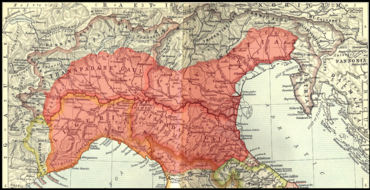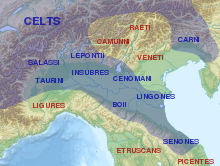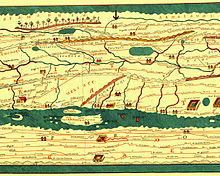Cisalpine Gaul

Cisalpine Gaul (
After its conquest by the
Cisalpine means "on this side of the Alps" (from the perspective of the Romans), as opposed to Transalpine Gaul ("on the far side of the Alps").[6]
Gallia Cisalpina was further subdivided into Gallia Cispadana and Gallia Transpadana, i.e. its portions south and north of the
The Roman province of the 1st century BC was bounded on the north and west by the Alps, in the south as far as
In 49 BC all inhabitants of Cisalpine Gaul received
History
Early history

The
The Veneti were an Indo-European people who inhabited north-eastern Italy, in an area corresponding to the modern-day region of the Veneto, Friuli, and Trentino.[22] By the 4th century BC the Veneti had been so Celticized that Polybius wrote that the Veneti of the 2nd century BC were identical to the Gauls except for their language.[23] The Greek historian Strabo (64 BC–AD 24), on the other hand, conjectured that the Adriatic Veneti were descended from Celts, who in turn were related to a later Celtic tribe of the same name whose members lived on the Armorican coast and fought against Julius Caesar. He further suggested that the identification of the Adriatic Veneti with the Paphlagonian Enetoi led by Antenor — which he attributes to Sophocles (496–406 BC) — had been a mistake caused by the similarity of the names.[24]
Gallic expansion and Roman conquest

In 391 BC, Celts "who had their homes beyond the Alps, streamed through the passes in great strength and seized the territory that lay between the Apennine mountains and the Alps" according to Diodorus Siculus. The Roman army was routed in the battle of Allia, and Rome was sacked in 390 BC by the Senones.[25]
The defeat of the combined Samnite, Celtic and Etruscan alliance by the Romans in the Third Samnite War ending in 290 BC sounded the beginning of the end of the Celtic domination in mainland Europe. At the Battle of Telamon in 225 BC, a large Celtic army was trapped between two Roman forces and crushed.[26]
In the
Roman province
Sometimes referred to as Gallia Citerior ("Hither Gaul"), Provincia Ariminum, or Gallia Togata ("Toga-wearing Gaul", indicating the region's early Romanization). Gallia Transpadana denoted that part of Cisalpine Gaul between the Padus (now the
Probably officially established around 81 BC, the province was governed from Mutina (modern-day
In 49 BC, with the Lex Roscia, Julius Caesar granted to the populations of the province full Roman citizenship.
The
The province was merged into Italia about 42 BC, as part of
Archaeology


Canegrate culture
The
The Canegrate culture testifies to the arrival of Urnfield
The population of Canegrate maintained its own homogeneity for a limited period, approximately a century, after which it blended with the Ligurian aboriginal populations to create the new Golasecca culture.
Golasecca culture
The
Language
There is some debate whether the
See also
- Northern Italy
- Canegrate culture
- Golasecca culture
- Cisalpine Gaulish
- Etruscans
- Iron Age Italy
- Ancient peoples of Italy
- Transalpine Gaul
References
- ^ The Historical Atlas by William R. Shepherd, 1911 edition
- ^ von Hefner, Joseph (1837). Geographie des Transalpinischen Galliens. Munich.
- ^ Umberto Moscatelli (2010). "University of Macerata. I Romani in montagna: tra immaginario e razionalità".
- ISBN 978-0-19-815300-9. Archived from the originalon 2020-05-22.
- ^ Long, George (1866). Decline of the Roman republic: Volume 2. London.
{{cite book}}: CS1 maint: location missing publisher (link) - ^ Snith, William George (1854). Dictionary of Greek and Roman geography: Vol.1. Boston.
{{cite book}}: CS1 maint: location missing publisher (link) - ^ Schmitz, Leonhard (1857). A manual of ancient geography. Philadelphia: Blanchard and Lea.
- ^ Cassius Dio XLI, 36.
- ^ Brouwer, Hendrik H. J. (1989). Hiera Kala: Images of animal sacrifice in archaic and classical Greece. Utrecht.
{{cite book}}: CS1 maint: location missing publisher (link) - ISBN 978-88-8289-851-9
- ^ Maps of the Golasecca culture. [1] "Archived copy". Archived from the original on 2011-07-22. Retrieved 2010-08-10.
{{cite web}}: CS1 maint: archived copy as title (link) - ^ G. Frigerio, Il territorio comasco dall'età della pietra alla fine dell'età del bronzo, in Como nell'antichità, Società Archeologica Comense, Como 1987.
- ^ Kruta, Venceslas (1991). The Celts. Thames and Hudson. pp. 52–56.
- ^ Stifter, David (2008). Old Celtic Languages (PDF). pp. 24–37.
- ^ Hazlitt, William. The Classical Gazetteer (1851), p. 297.
- ^ Polo, Francisco Pina. "Deportation of Indigenous Population as a Strategy for Roman Dominion in Hispania". Limes Xx Gladius, Anejos 13, 2009.
- ^ Boardman, John (1988). The Cambridge ancient history: Persia, Greece and the Western Mediterranean c. 525-479 BC. p. 716.
- ^ Baldi, Philip (2002). The Foundations of Latin. Walter de Gruyter. p. 112.
- ISBN 9782877722377.
- ^ Kruta, Venceslas (1991). The Celts. Thames and Hudson. p. 54.
- ^ Kruta, Venceslas (1991). The Celts. Thames and Hudson. p. 55.
- ^ Storia, vita, costumi, religiosità dei Veneti antichi at .www.venetoimage.com (in Italian). Accessed on 2009-08-18.
- ^ History of the Roman World: 753 to 146 BC by H. H. Scullard,2002, page 16: "... of healing. In the fourth century, their culture became so Celticized that Polybius described the second-century Veneti as practically in- distinguishable ..."
- ^ Strabo, Geography, Book IV, Chapter 4: "It is these Veneti [the Gallic tribe of the Belgae], I think, who settled the colony that is on the Adriatic (for about all the Celti that are in Italy migrated from the transalpine land, just as did the Boii and Senones), although, on account of the likeness of name, people call them Paphlagonians. I do not speak positively, however, for with reference to such matters probability suffices." Book V, Chapter 1: "Concerning the Heneti there are two different accounts: Some say that the Heneti too are colonists of those Celti of like name who live on the ocean-coast; while others say that certain of the Heneti of Paphlagonia escaped hither with Antenor from the Trojan war, and, as testimony in this, adduce their devotion to the breeding of horses — a devotion which now, indeed, has wholly disappeared, although formerly it was prized among them, from the fact of their ancient rivalry in the matter of producing mares for mule-breeding." Book 13, Chapter 1: "At any rate, Sophocles says that [...] Antenor and his children safely escaped to Thrace with the survivors of the Heneti, and from there got across to the Adriatic Henetice, as it is called."
- ^ "CLADES GALLICA - SACCO DI ROMA (390 a.c.)" (in Italian). Retrieved 5 July 2023.
- ^ "BATTAGLIA DI TALAMONE (225 a.c.)" (in Italian). Retrieved 5 July 2023.
- ^ "L'ombra di Annibale. Amilcare e l'insurrezione della Gallia Cisalpina (200-197 a.C.)" (in Italian). 31 March 2022. Retrieved 5 July 2023.
- ^ Livy, 36.38
- ^ Fasti Triumphales
- ISBN 9781526710093.
- ^ Uchicago.edu
- ^ The Dawn of the Roman Empire, by Livy, John Yardley, Waldemar Heckel.
- ISBN 978-88-8289-851-9
Further reading
- Arslan E. A. 1992 (1995), La Nécropole celtique de Garlasco (Province de Pavie), in L’Europe celtique du Ve au IIIe Siècle avant J.-C. (Hautvillers, 8-10 octobre 1992), Sceaux, pp. 169–188.
- Luigi Bossi, Della istoria d'Italia antica e moderna, Milano, 1819
- Jean Bousquet, La Cisalpine gauloise du IIIe au Ier siècle avant J.-C.
- Corbella, Roberto: "Celti : itinerari storici e turistici tra Lombardia, Piemonte, Svizzera", Macchione, Varese c2000; 119 p., ill.; 20 cm; ISBN 9788883400308
- Corbella, Roberto: "Magia e mistero nella terra dei Celti : Como, Varesotto, Ossola"; Macchione, Varese 2004; 159 p. : ill. ; 25 cm; ISBN 9788883401862
- D'Aversa, Arnaldo: "La Valle Padana tra Etruschi, Celti e Romani", PAIDEIA, Brescia 1986, 101 p. ill., 21 cm, ISBN 88-394-0381-7
- Raffaele De Marinis and Venceslas Kruta in ‘’Italia, omnium terrarum alumna’’, Garzanti-Scheiwiller, 1990
- ISBN 88-304-1012-8
- Grassi, Maria Teresa: "La ceramica a vernice nera di Calvatone-Bedriacum", All'Insegna del Giglio, Firenze 2008, pp. 224 brossura, ISSN/ISBN 9788878143692
- Grassi M. T. 1995, La romanizzazione degli Insubri. Celti e Romani in Transpadana attraverso la documentazione storica e archeologica, Milano.
- Grassi M. T. 1999, I Celti della Cisalpina Centrale: dall’ager Insubrium alla XI Regio Transpadana, in Insubri e Cenomani tra Sesia e Adige, Seminario di Studi (Milano 27-28.2.1998), “Rassegna di Studi del Civico Museo Archeologico e del Civico Gabinetto Numismatico di Milano”, LXIII-LXIV, pp. 101–108.
- Lawrence Keppie, The Making of the Roman Army, From Republic to Empire, University of Oklahoma, 1998
- Kruta, Venceslas: "I celti e il Mediterraneo", Jaca Book, 2004, 78 p., ISBN 978-88-16-43628-2
- Kruta, Venceslas: "La grande storia dei celti. La nascita, l'affermazione e la decadenza", Newton & Compton, 2003, 512 p., ISBN 978-88-8289-851-9
- Kruta, Venceslas & ISBN 978-88-04-47710-5
- Giuseppe Micali, L'Italia avanti il dominio dei Romani, Genova, 1830
- Smith, William, ed. (1854). "Gallia Cisalpina". Dictionary of Greek and Roman Geography. London: Walton and Maberly.
- Violante, Antonio; introduzione di ISBN 88-366-0442-0

